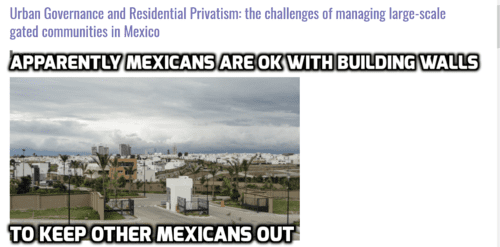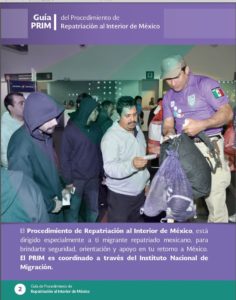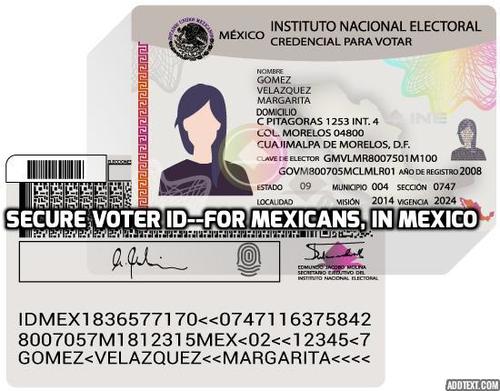We go to Mexico each summer, to visit my wife’s family and stay in the metropolitan area in which we formerly resided. It’s also a good way to spend some time in Mexico and see things firsthand, visit friends, and even buy some items not available where we reside in the U.S.
My 15-year old son, who has his driving permit, got a lot of practice driving in Mexico, learning to drive defensively and never taking anything for granted! Valuable training indeed!
And although a certain Fred Reed denies it, I must sadly report that the litter problem is still bad in Mexico.
After crossing the border to get into Mexico, I obtained my personal tourist permit and my vehicle permit in the Mexican border station.
![]() There is a section in that station of which I’ve reported before, called Repatriación Humana which means “Humane Repatration”. It’s a section to receive Mexican deportees and self-deportees from the United States. The goal is to receive them back in to Mexico and help them out.
There is a section in that station of which I’ve reported before, called Repatriación Humana which means “Humane Repatration”. It’s a section to receive Mexican deportees and self-deportees from the United States. The goal is to receive them back in to Mexico and help them out.
The day I entered, I saw some people there who were being repatriated. They had food and drink which had been provided to them.
When I left Mexico several weeks later, however, there weren’t any returnees at the time I passed through the station. I wasn’t there long, I guess there just didn’t happen to be any at that time.
We went to Mexico when we did so my wife could vote in the July 1st Mexican election. (She is a Mexican citizen and a legal resident, but not a citizen, of the U.S.A.).
Once again, I was impressed by the Mexican voter registration system, which is surely worthy of emulation.
I accompanied my wife (and her parents) to their regular voting station and observed the procedure. Of course, as a non-Mexican citizen, I didn’t vote nor did I meddle in the process.
![]() Each Mexican voter is issued a photo voter ID by the government. The poll workers and the party observers have access to books which contain the photographs of each and every voter in the precinct. They check the photos.
Each Mexican voter is issued a photo voter ID by the government. The poll workers and the party observers have access to books which contain the photographs of each and every voter in the precinct. They check the photos.
Also, each voter’s thumb is smudged with ink, so if he shows up at another precinct that will be seen. (The ink wears off after several days).
Contrast the Mexican system with our slipshod voter registration in the United States. If you call for photo voter ID, you can be accused of trying to “disenfranchise” minority voters.
So why can Mexico do it and it’s bad for us?
The winner of the election was Andres Manuel Lopez Obrador, known by AMLO, an acronym formed by his initials. This was AMLO’s third time to run for president, and this time he won it. Not only did AMLO win, but his coalition won a majority in the Mexican Congress.
AMLO takes office on December 1st but the new Congress is in office as of September 1st.
We had a good visit. Of course, I don’t go there to debate immigration and Trump. After all, it’s not the job of Mexicans to reform our immigration system – that’s our job.
However, Trump did come up in conversation a few times, and so did the “family separation” immigration issue.
But in the conversations I was involved in, I didn’t hear a lot of Trump-bashing. I’ve found that regular Mexicans will at least listen to what I say on these issues.
And they sometimes acknowledge the same problems that we do. For example, the way Mexico allows all these Central Americans to pass through Mexico to get to the U.S.
We also got some mechanical work done on our car. Mechanical work in Mexico is much cheaper than in the United States. So is plumbing and carpentry. It’s because Mexican wages are lower than American wages.
So what happens if you move a lot of Mexican workers, legally or illegally, to the United States? Well, they can be paid higher wages than they’d get in Mexico, but at a rate that is lower than the living wage needed by an American worker. So why can’t people see that this is a problem?
Another interesting thing has to do with Mexican construction. You know how we’re told that walls are bad, and we should be building bridges instead.
Well, in Mexico, walls are all over the place. Houses have walls, sometimes topped with broken glass as a deterrent against climbing over. Schools have walls. A school I used to work at would loose ferocious dogs in the schoolyard at night.
The urban area where we were visiting (where we formerly resided) has been having a housing boom in recent years. It’s really growing. And I can’t help but note how common gated communities are.
These gated communities have walls around them. The only way to drive in or out is to pass through a checkpoint (with a guard) controlling access.
Isn’t that interesting?
And isn’t that that what we want to do with our own country? Controlling access – is that so bad?




 There is a section in that station of which I’ve
There is a section in that station of which I’ve  Each Mexican voter is issued a photo voter ID by the government. The poll workers and the party observers have access to books which contain the photographs of each and every voter in the precinct. They check the photos.
Each Mexican voter is issued a photo voter ID by the government. The poll workers and the party observers have access to books which contain the photographs of each and every voter in the precinct. They check the photos. 








